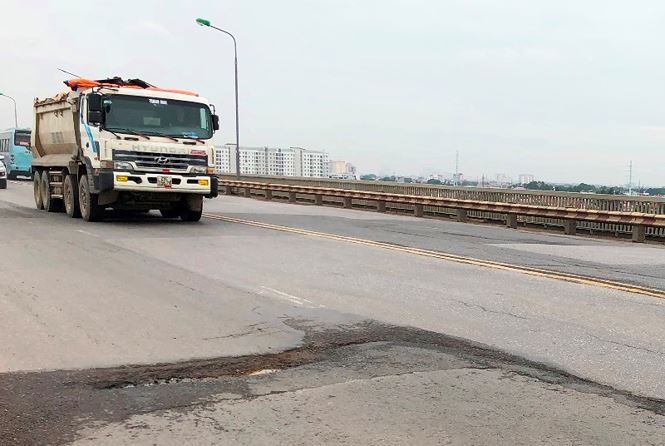 Society
Society

Hà Nội’s Transport Department has asked the Ministry of Transport to fix cracks and subsidence that have reappeared on the surface of Thăng Long Bridge over the last few months, threatening road safety.
 |
| Hà Nội’s Transport Department has asked the Ministry of Transport to fix cracks and subsidence that have reappeared on the surface of Thăng Long Bridge over the last few months, threatening road safety.— Photo tienphong.vn |
HÀ NỘI — Hà Nội’s Transport Department has asked the Ministry of Transport to fix cracks and subsidence that have reappeared on the surface of Thăng Long Bridge over the last few months, threatening road safety.
Thăng Long Bridge, spanning about 3,116 metres, was built with Russian assistance in 1985, crossing the Red River to connect Nội Bài Airport with downtown Hà Nội.
The bridge is under the management of the ministry’s Directorate for Roads of Việt Nam. Since 2009, the ministry wanted to transfer the Bắc Thăng Long – Nội Bài Route (now known as Võ Văn Kiệt Street) including Thăng Long Bridge to Hà Nội for management because of the city’s expansion in 2008, the whole route is within Hà Nội’s territory, making it an urban road.
However, the transfer was delayed as the bridge was being repaired at that time.
Authorities spent roughly VNĐ100 billion ($4.8 million) on resurfacing the bridge in 2009, but severe cracks have since reappeared.
According to experts, one of the reasons for the poor quality of the road surface is that the rolling and pressing process of the stone mastic asphalt was below 120 degrees Celsius, negatively affecting the surface quality. Rainwater drainage systems have also not worked properly, leading to stagnant water and damaging the bridge’s surface.
Head of Road Management Department 1 under the directorate Trần Hưng Hà told Tiền Phong (Vanguard) newspaper that after the major maintenance in 2009, cracks would reappear on the bridge surface, especially after prolonged rain or heat with temperatures reaching over 40 degrees Celsius.
“Under harsh weather conditions, the bridge surface cracks and asphalt concrete breaks, weakening the structure with the weight of vehicles,” Hà said.
Last year, about VNĐ1.4 billion was spent on fixing the bridge surface and in 2016, the maintenance cost over VNĐ1 billion, he said.
Hà Nội’s hesitation in taking ownership of the bridge is blamed on these high maintenance costs.
Hà Nội asked the Transport Ministry and its relevant agencies to examine and fix the bridge’s surface before handing it over to the city.— VNS




